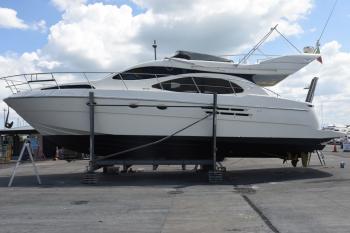 Give your boat a really good clean!
Give your boat a really good clean!
Sounds obvious but a clean boat will endure the winter months much better and reduces preparation time to get the boat back on the water.
- Outsides and upsides: start by giving the decks, underside and topsides a good clean with warm water, for those stubborn areas a steam cleaner can save a lot of energy, a little wax wouldn’t hurt at this stage either and can help longevity of the boats materials. Wipe down all hardware with a suitable product, such as Simple Green, and shammy off excess water.
Wipe down all stainless with a wax polish to prevent corrosion - Check the hull for flaking on fiberglass hulls and panels and repair them as required. Any canvas, spray hoods and windscreens should also be cleaned off to remove residue salts from the general area.
- Ensure that the boat is as dry as possible before putting into storage, damp is not your friend. If the boat is to be stored outside, ensure that a suitable cover is used that not only fully protects the boats internals and decks from rain but also the hull from the cold and wet.
- Mould is not your friend, defend against it! Where possible, take soft furnishings home and keep them somewhere cool and dry. This will help retain the quality of the product as well as keep them fresh and clean. Where furnishings may be too large to take home, try to hang them so that air can circulate throughout the boat. If there is little circulation in the storage area, a low power de-humidifier can help.
- Ensure that any perishables and removables are removed: Fridges and freezers should be cleaned, food removed, as well as any other removable items such as flares, fire extinguishers, fenders and electronics.
The Head
This is one area that should be cleaned fairly regularly however for winterising there are a couple of additional things you can do. While pumping out, at your local approved facility, add fresh water and flush through several times to help clean the system. If the boat remains in the water ensure that a bucket full of fresh water is used to fill the toilet bowl and left to level through the system, rembering that a head smell is only salt water ‘going off’.
Ensure your engine is as ready now as it should be for next season
- A professional service is clearly the best treatment. Although engines can appear complicated, there are some must do actions that will help increase the lifespan and efficient running come spring.
- Change your boats oil: Water and acids in the oil can degrade and corrode the metals in the engine given enough time, fresh oil greatly reduces the chances of foreign liquids being present. Ensure that you run the engine for some time before changing the oil, this helps the viscosity of the oil and leads to a much cleaner, and quicker, oil change.
- Drain and refresh the boat’s engine cooling system: Draining the coolant alone it’s not quite enough, ensure that you run clean water through the system.
- Keep your drive belts driving your forward: Drive belts should be loosened as they are under high tension and can crack during storage, this of course could lead to a costly inconvenience.
- Moving parts, no problem: For this stage, consult your engines manufacturing guide as each boat can vary however, spray fogging oil either through the spark plug holes or into the carburettor whilst the engine is turning over. This helps ensure that as much of the engines internal moving parts are oiled.
- Help your boat steer you: Steering mechanisms are, as you will be aware, very important parts of the engine and equal care should be given to it during the winterising process. Ensure that they are well greased deep into the joints and that everything continues to move freely. Any obstructions could lead to stored tension and cracking / sheering.
How to winterise your fuel
Fuel can be left in the tank however a little preparation should be taken if it is to sit there for months on end. Fill the tank to within 1inch full, allowing for expansion on warm days, and add in a suitable fuel stabilising agent. As fuel can break down, it’s important to run the engine to draw the stabilising agent through the engine with the fuel for 10 to 15 minutes ensuring good coverage. To further alleviate condensation, add some Vaseline around the fuel cap to prevent unwanted moisture getting in and out.
It may also be worth considering the replacement of pre-fuel filters as any issues at this stage can be resolved during the winter months ensuring that your boat is in first class condition come spring or summer.
Disconnect your battery!
The cost of replacing a boats battery can be steep, save yourself some cash and disconnect the battery at the end of the winterising process. Further to this, giving them a charge from the mains (land power) and topping up with distilled water could help the lifespan. Please consult your batteries manufacturer before making any changes outside of disconnecting the battery.
Check regularly
Although the above check points are great to do before your boat goes into storage, there is no greater thing that to check regularly. Visiting your boat during the winter months can raise awareness for potential problems early and ensure plain sailing when the time comes to launch your boat in the spring / summer months.
Also pay close attention to the manufacturers manual, each make and model is different and the best care will often be available to view, if in doubt a call to the manufacturer or Yachtfindeers Global to assist. Our, after-sales maintenance team or a specialist can alleviate any concerns and deliver the best results.
Want to know more?
For support, more information or for professional winterisation why not contact us.

